Rich Snippets: What They Are, and How to Win Them
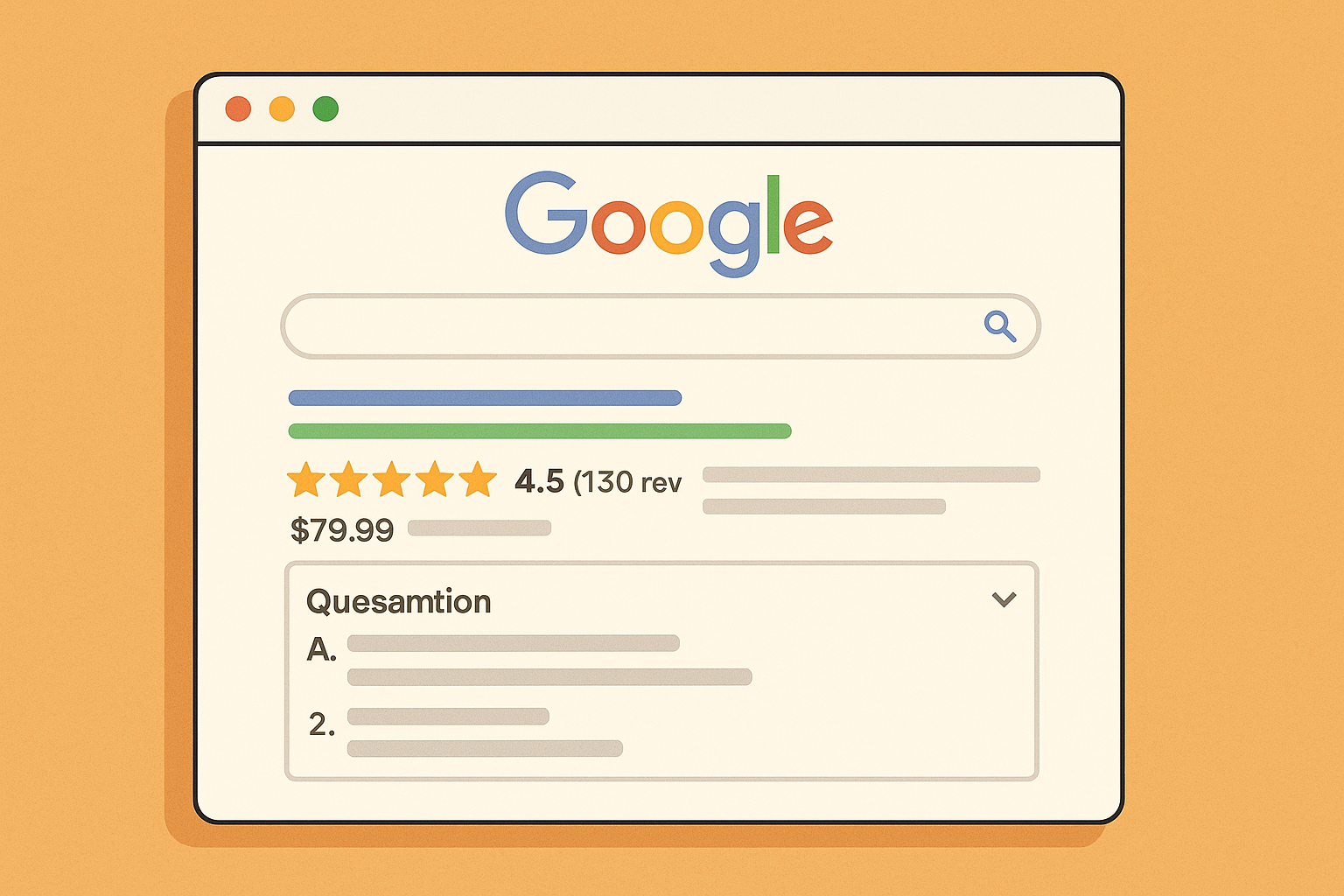
Rich Snippets: What They Are, and How to Win Them
Ever searched for something on Google and noticed specific results looked more helpful than others? They could have star ratings, a quick how-to list, or even an FAQ dropdown, all without requiring you to click.
Those fancy results are called rich snippets, and if you’re in the SEO game, they’re gold.
They help you stand out in the crowded SERPs, attract more clicks, and even boost your credibility.
And the best part? You don’t need to rank number one to win them.
In this guide, we’ll walk you through:
- What rich snippets are,
- Why they matter,
- The types you can target,
- And how to optimize your content to show up there.
Let’s get into it.
What Are Rich Snippets and Why Do They Matter?
Rich snippets are enhanced search results that display extra information pulled from structured data on a web page.
Think of them as Google giving users a sneak peek of your content, beyond just the blue link and meta description. This can include things like:
-
Star ratings
-
Prices
-
Review counts
-
How-to steps
-
FAQs
-
Product details

Technically, rich snippets are powered by structured data markup, also known as schema markup.
It’s like adding extra labels to your content so Google understands it better and can present it in a richer format.
They matter in SEO because they make your search listings stand out, significantly improving your visibility and click-through rates (CTR).
Here are a few more reasons why they’re a big deal:
1. They Grab Attention
Rich snippets add extra details to your regular search results. That extra visual real estate catches users’ eyes and can draw clicks away from higher-ranked but less detailed results.
For example, a product page with a star rating and price tag looks more trustworthy and informative than a plain blue link.
2. They Boost CTR
According to several studies, search results with rich snippets have a 5-30% higher click-through rate than plain results. Google also reports that sites in highly competitive niches like healthcare and finance are 80% more likely to be clicked if they’re accompanied by a rich snippet.
Even if you’re in position three or four, rich snippet enhancements can help you outperform the top results in clicks.
3. They Help Build Trust
Providing details such as reviews, author information, or step-by-step instructions can instantly establish credibility with users. They’re more likely to click on a result that feels reliable, complete, and relevant.
4. They Improve Relevance in Search
Rich snippets are tied to structured data (like schema markup), which helps Google better understand your content. That, in turn, can improve your rankings or make your content eligible for other SERP features like People Also Ask, People Also Search For or Featured Snippets.
Types of Rich Snippets You Can Win
Google offers several types of enhanced results, depending on your content and its structure. Some are great for bloggers, others for eCommerce stores, local businesses, recipe creators—you name it.
Let’s walk through some of the most common (and valuable) types of rich snippets you can aim for:
Review Snippets (Star Ratings)
You’ve probably seen those golden stars under product listings, course reviews, or even recipe blogs.
They show up when Google pulls an average rating (out of 5) and review count from structured data on your page.
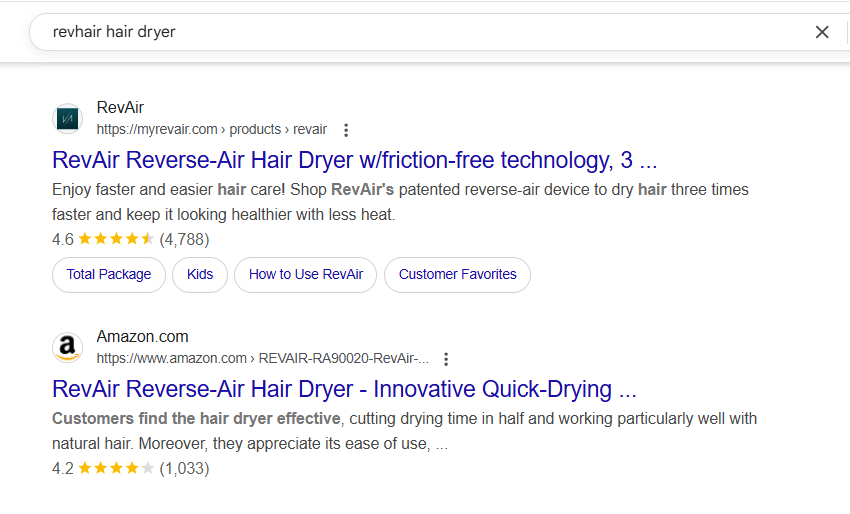
These snippets instantly grab attention, and since people are psychologically drawn to social proof, a 4.2/5 or 4.5/5 can nudge people to click your result instead of the one above it. In fact, studies find that these ratings boost click-through rates by a staggering 10-30%.
Take this review for example. Though it ranks a bit lower for the keyword “low-budget espresso machine,” the added reviews instantly make it stand out from the rest of the results:
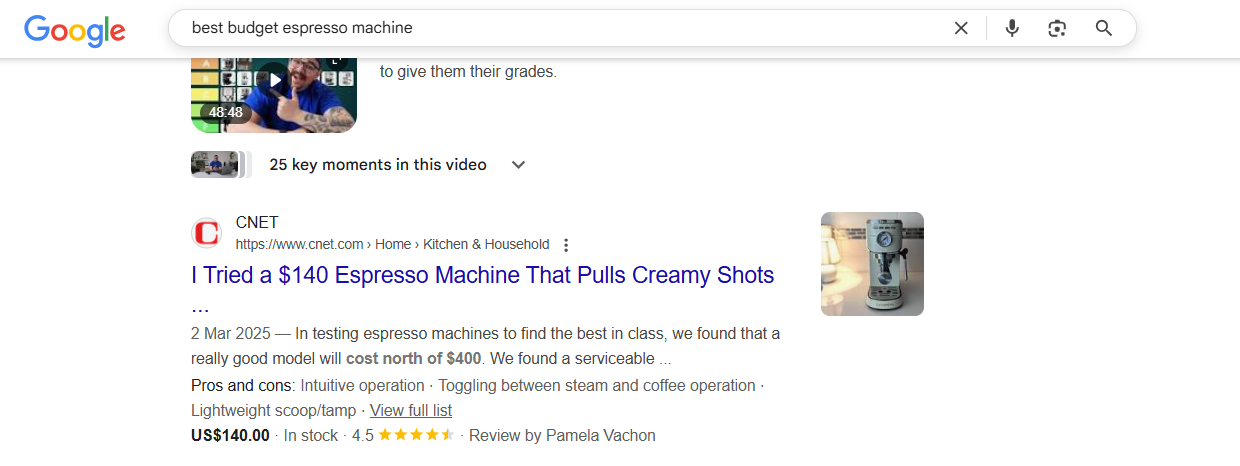
This is especially useful for:
- Product review blogs
- Online course platforms
- SaaS tools and marketplaces
- Hospitality and local businesses, and more
FAQ Snippets
This is a collapsible Q&A box that appears below your search result, showing 2 to 4 commonly asked questions (and your answers) directly in the SERPs. The FAQ snippet takes up way more space in the search results and positions you as a go-to source for helpful, skimmable info.
This shouldn’t be confused with the “People Also Ask” box, which pulls answers from several results, not just yours.
Let’s say you run a blog post titled “How to Use ChatGPT for SEO.” If you structure your content correctly, you might appear in search results with a collapsible FAQ that includes:
Q: Can you use ChatGPT for SEO?
A: Yes, ChatGPT can assist with keyword research, content outlines, and even schema markup generation.
Q: Is ChatGPT accurate for SEO tasks?
A: Mostly, yes, as long as you fact-check its suggestions and supplement with current SEO data and best practices.
That kind of immediate value builds trust and invites clicks.
Here’s how this looks on the SERPs:
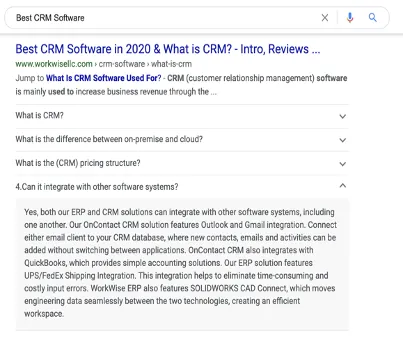
Source: Content Marketing Institute
How-To Snippets
How-to rich snippets are step-by-step instructions pulled directly into Google’s search results, often displayed with visuals, time estimates, or a numbered list. They’re incredibly useful for users who want quick answers without needing to click through to a website.
These snippets make your content more prominent in the SERPs, giving it extra space and visual appeal. They’re especially effective for content creators in DIY, home improvement, software tutorials, beauty, and fitness.
Recipe Snippets
Imagine googling “best vegan chocolate cake” while standing in your kitchen, flour on your shirt, and mixing bowl in hand. Among dozens of blue links, one result stands out.
It’s not just a title, but a mouthwatering preview: 45-minute cook time, 180 calories per slice, five-star rating, and a thumbnail image of a perfectly frosted cake.
That’s the power of recipe rich snippets. They serve your content on a silver platter, right in the search results.
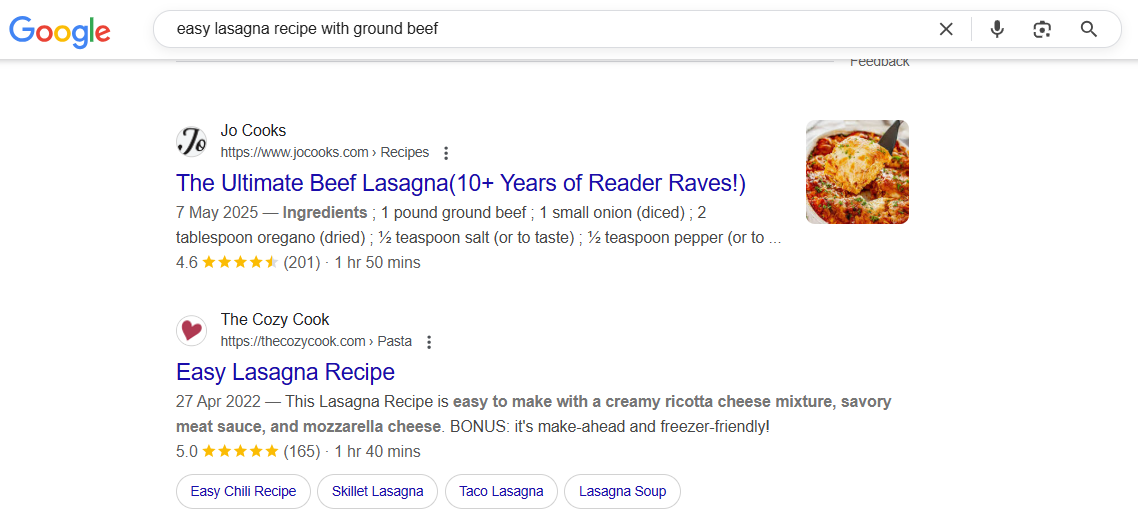
These snippets are perfect for food bloggers, culinary brands, and wellness sites with recipe sections. To earn one, structure your content using Recipe schema and include key details like ingredients, prep, and cook time, calories, instructions, and (ideally) an eye-catching image.
Product Snippets
Product rich snippets display key shopping details, like price, stock status, product name, and star ratings, directly in the search results.

For users comparing options, this snippet functions like a mini storefront, helping them decide which item to click without needing to open multiple tabs. It’s an instant attention-grabber, especially when searchers are already in purchase mode and looking for trustworthy, detailed product info at a glance.
To qualify, implement Product, Offer, and AggregateRating schema markups on your pages. Make sure your price, availability, and review ratings are up-to-date and visible on the page. Google pulls this info directly to power the snippet, so accuracy matters.
Event Snippets
If you’re hosting an event, such as a virtual webinar through a webinar platform, local concert, in-person conference, or product launch, you’ll want to optimize for event-rich snippets.
These snippets display key event details like the name, date, location, and registration link directly on the Google search results page.
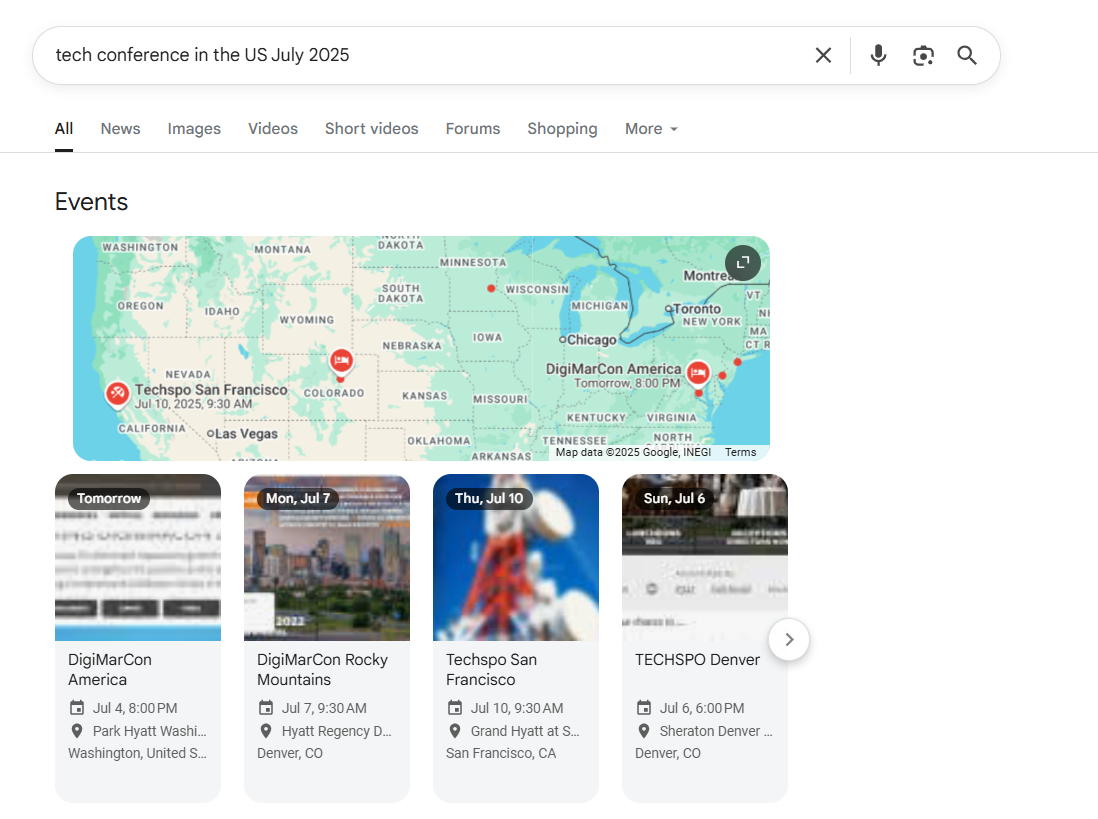
It’s like giving your audience a front-row ticket without them needing to click around. And for time-sensitive events, this kind of visibility can make all the difference.
Video Snippets
Are you looking to boost your video content’s visibility in search results? Video-rich snippets are the way to go. These enhanced listings display an eye-catching thumbnail, the video’s length, and often a “Key Moments” timeline that allows users to jump to specific sections instantly.
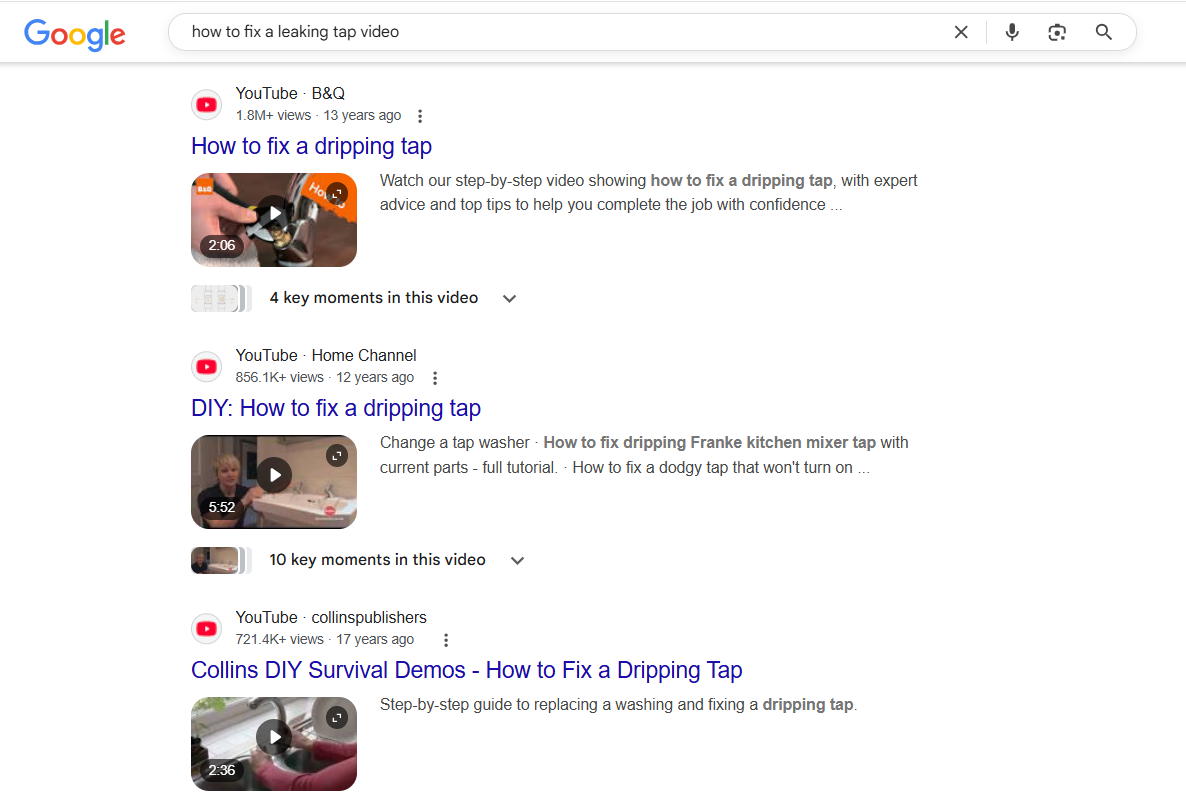
It’s a powerful way to stand out, especially for content like tutorials, product demos, reviews, or walkthroughs.
How to Optimize for Rich Snippets and Earn Those Coveted Spots
Here’s the thing:
You don’t get rich snippets just because your content is good.
You get them because your content is clear, well-structured, technically optimized, and matches what Google is looking for.
It’s like showing up to a VIP party: You need the right outfit, the perfect invite, and a bit of charm.
Let’s break it down:
Use the Right Schema Markup
Schema markup is like handing Google a set of precise instructions for reading your content.
Instead of relying on assumptions, search engines receive clear, structured data that explicitly tells them what your page contains, be it a recipe, a product listing, a set of FAQs, or a how-to tutorial.
The easiest way to add schema is through JSON-LD (Google’s preferred format), but if you’re using WordPress, plugins like Yoast can simplify the process.
If you’re more technically inclined or have a developer handy, you can also implement the code manually.
Here’s how to get it right:
- Pick the right schema type: Head to Schema.org and search for the format that fits your content, such as FAQPage, Product, Review, or HowTo.
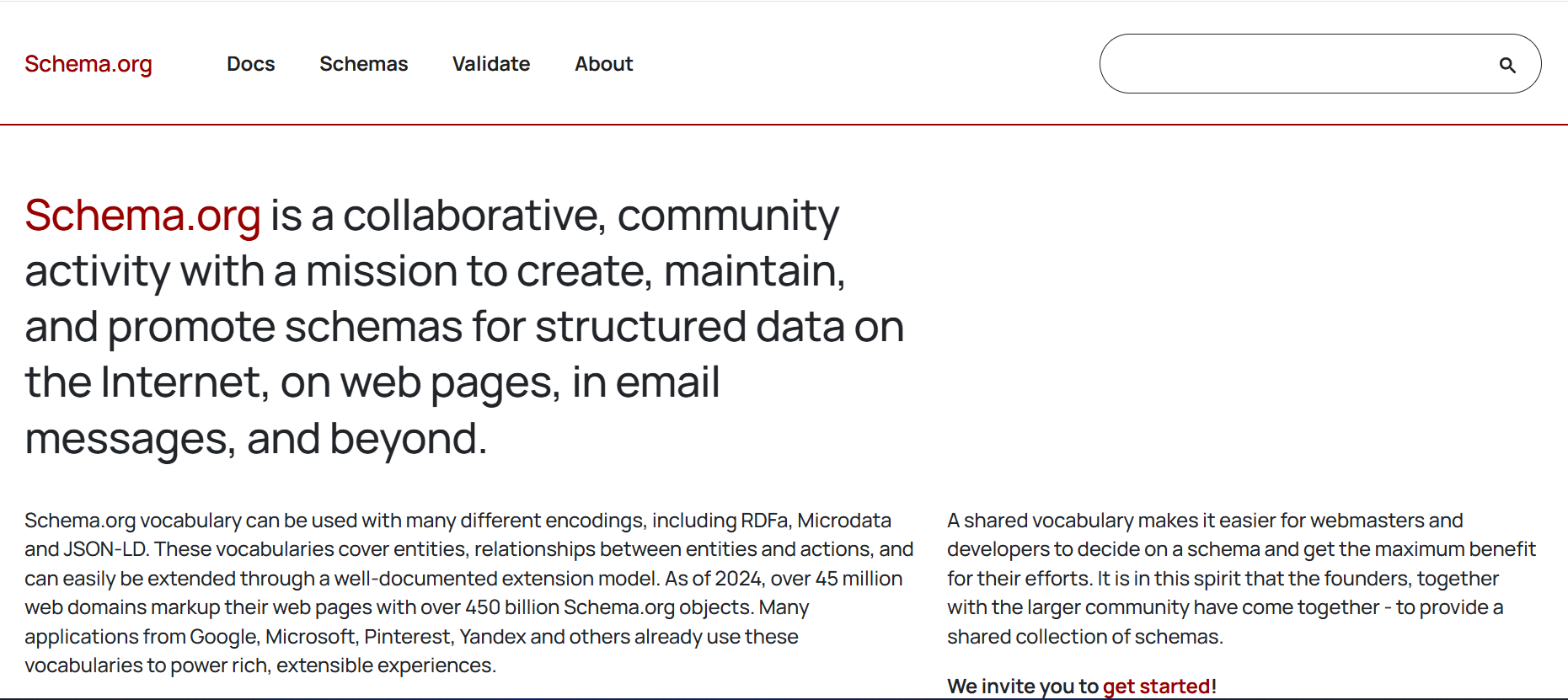
If you want to optimize for a Review snippet, for instance, type “review” in the search bar:
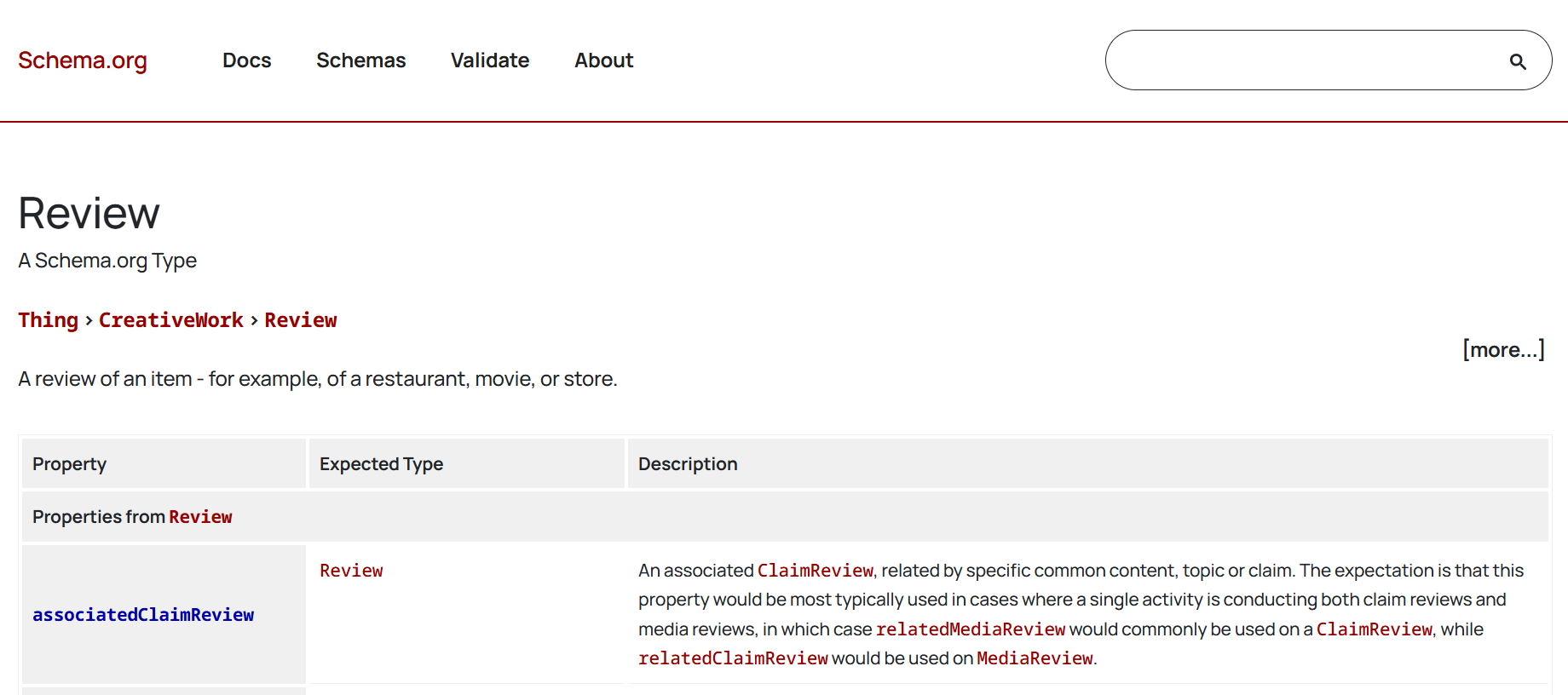
Then, markup your content following the instructions on the page:

-
Test before you publish: Use Google’s Rich Results Test to ensure your markup is correctly implemented and eligible for enhanced display.
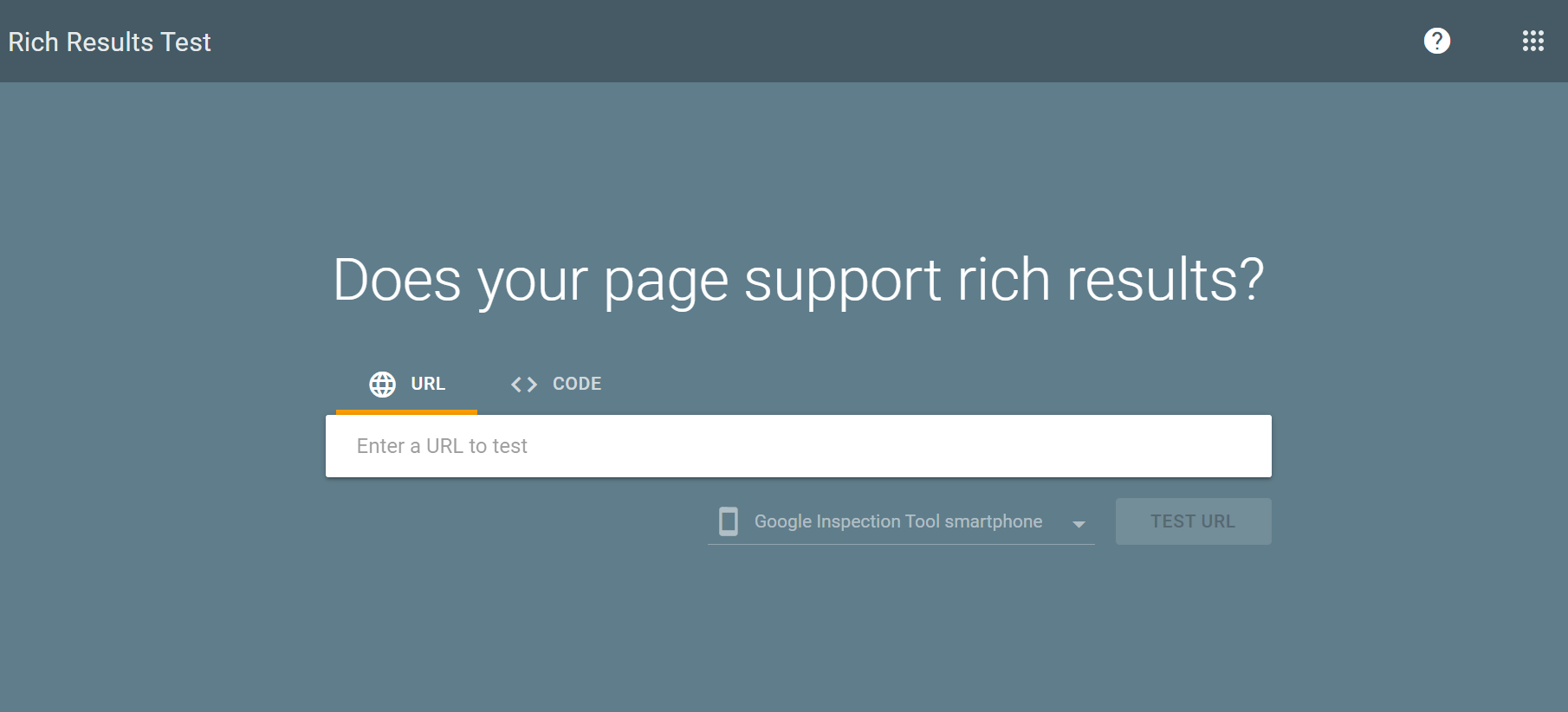
-
Keep it honest: Only add schema to content that’s visible on the page. If you try to mark up invisible or misleading content, Google might ignore your markup—or worse, penalize your site.
Used properly, schema helps your content stand out in the SERPs and increases your chances of winning rich snippets.
Match Search Intent Fast
Google’s goal is simple: to serve users the most helpful answer as quickly as possible. So if your content buries the lead through unnecessary fluff before getting to the good stuff, it’s going to struggle, especially when it comes to winning rich snippets.
To increase your chances of being featured, you need to align closely with search intent, which means understanding why someone is searching in the first place and being direct in your approach.
For example, if someone searches “What is employee onboarding?”, they’re likely looking for a definition, not a long-winded backstory. You’d want to say:
Employee onboarding is the process of integrating new hires into a company and equipping them with the necessary tools, knowledge, and relationships to succeed.
Then, you can expand with a few paragraphs explaining why it matters, what the process involves, or how it varies by company.
Here’s how to do that effectively:
- Start with a direct answer: In the first two or three sentences of each relevant section, give a clear, concise response to the user’s query. This is what Google is most likely to pull into a snippet.
- Use search-friendly subheadings: Structure your content with subheadings that reflect actual search terms and questions (such as “How do you install WordPress?” or “What are the benefits of employee onboarding?”). This helps Google quickly match your content with user queries.
- Add helpful context, but don’t bury it: Once you’ve delivered the answer, you can elaborate with examples, use cases, or a step-by-step breakdown. Think of it like a pyramid: start narrow and sharp, then build out.
Getting this balance right — fast answers up front, with rich detail below — is what helps your content satisfy both users and search engines.
Format for Scannability
Google is picky. It loves content that’s easy to digest, for both readers and crawlers.
So your formatting matters just as much as your writing.
- Use short paragraphs (2–4 lines max)
- Add bullet points or numbered lists to outline steps, features, pros, and cons.
- Bold key phrases for emphasis
- Include subheadings every 200–300 words.
- Use tables when comparing items or data.
If you’re answering “What are the steps to onboard a new hire?”, use a clean list format:
1. Send a welcome email
2. Set up IT access
3. Schedule intro meetings
4. Assign a mentor
5. Conduct training sessions
This structure is ideal for How-To and FAQ snippets.
Include Images and Videos When Relevant
While not all rich snippets include media, some categories, such as how-to, recipe, product, and video snippets, benefit significantly from supporting visuals.
For instance, a blog post titled “How to Frost a Cake” that includes an embedded YouTube video and images has a much better shot at a rich snippet than a plain-text version.
Google can display:
- Thumbnails beside your search result (from images or video stills)
- Step images in HowTo results
- Product images for eCommerce listings
To maximize this:
- Add high-quality, relevant images to your content
- Use descriptive alt text (Google uses this to understand your visuals)
- For video content, include structured data using the VideoObject schema and use timestamps for key segments.
- Refresh and Update Content Regularly
- Google prefers fresh, up-to-date content, especially when it comes to snippets that address topics such as SEO, marketing, health, or finance. If your content hasn’t been updated in 2–3 years, your chances of being pulled into a snippet drop, even if you once held the spot.
So, make it a routine to:
- Update outdated statistics and screenshots
- Add new FAQs or user questions to the article
- Replace or refresh the schema markup if it changes
- Remove broken links or tools that are no longer relevant
- Even a minor update, such as adding a new paragraph or optimizing a heading, can signal to Google that your page is still active and relevant.
Build Topical Authority Through Content Clusters
To consistently earn rich snippets, you need to become a go-to authority on the topic. That means showing depth, variety, and consistency across related articles.
Let’s say you’re aiming to rank for “employee onboarding.” Don’t stop there. Build out content that surrounds the topic from every angle, like:
- “Best onboarding tools for remote teams”
- “Onboarding vs. orientation: What’s the difference?”
- “How long should onboarding last?”
Publishing this kind of interconnected content signals that you truly understand the subject and deserve to rank higher for it.
To build that kind of topical authority:
- Create topic clusters that cover different facets of the topic
- Practice internal linking to strengthen the connections between them.
- Offer a mix of beginner, intermediate, and expert-level content.
- Use keyword-rich internal anchor text that clarifies what each page is about
Over time, this layered approach positions your site as the expert, not just in one article, but across an entire category.
Track, Test, and Tweak
Finally, rich snippets aren’t something you win once and forget about. Search intent changes, algorithms evolve, and competitors constantly refine their content to outrank you.
That’s why monitoring performance and experimenting with your strategy regularly is essential.
With Nightwatch’s rank tracker, staying on top of rich snippet performance becomes much easier.
Use the rank tracker to:
- Identify which of your pages are triggering rich results like FAQs, product listings, or how-to snippets, so you can double down on what’s working.
- Spot missed opportunities: pages that have the correct schema but aren’t surfacing as snippets.
- Track keyword intent shifts: if Google starts prioritizing how-to guides over FAQs for a target keyword, you’ll notice the trend and can adapt accordingly.
- Monitor which snippets your competitors are winning, and uncover areas where you can improve your content to claim those positions.
![]()
Once you’ve got the insights, it’s time to test and iterate. Try:
- Adding or refining schema types
- Tweaking heading formats to better match user queries
- Experimenting with answer length and formatting (lists, tables, paragraphs)
- Updating content regularly to maintain freshness and snippet eligibility
Frequently Asked Questions
What is a rich snippet?
A rich snippet is a special type of search result that displays extra information beyond the standard blue link and meta description. This added data, like star ratings, product prices, images, FAQs, how-to steps, and event dates, is pulled directly from your content using structured data (schema markup).
Do rich snippets help SEO?
Yes, rich snippets can significantly improve your SEO performance, particularly in terms of visibility and traffic. While they don’t directly impact your Google rankings, they make your results more noticeable and engaging by including helpful visuals or data.
How to get a rich snippet?
Obtaining a rich snippet requires structuring your content in a way that search engines can easily understand. Start by identifying the type of snippet you want to appear, such as a how-to, product review, FAQ, or video. Next, apply the correct schema markup to your content. Make sure your content is clean, concise, and answers searchers’ questions. Finally, use Google’s testing tools to validate your structured data and track your eligibility.
Level Up Your Visibility with Rich Snippets
Getting to the top of Google is just the beginning. Standing out is what truly makes a difference.
Rich snippets give your content that visual edge: they make your listings more clickable, more trustworthy, and more useful at a glance.
But they don’t happen by chance.
Winning rich snippets requires thoughtful content, the proper schema markup, and ongoing optimization. You need to keep your site clean, your structure smart, and your strategy sharp.
And with a rank tracking tool like Nightwatch, you can see which of your pages are earning rich results, which ones have potential, and what tweaks you need to make next.
So, get started with Nightwatch today and turn your content into the kind Google loves to feature front and center.
Newsletter
Subscribe to our newsletter
Join our newsletter to be the first to access Nightwatch's cutting-edge tools, exclusive blog updates, and fresh wiki insights. Transform your online presence today!
